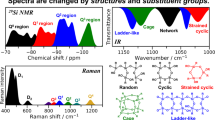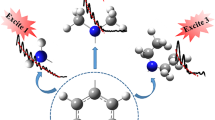Abstract
This mini review deals with the modern aspects of the spectroscopy and structural elucidation of amino acid derivatives and small biologically active compounds. Free peptide bond rotation in these systems yields various conformers, which possess differing biological activities. Another phenomenon is the intermolecular or intramolecular stacking observed in aromatic small peptides. Specifically, the main aim is to illustrate the successful application of the “complex tool”, consisting of a combination of the theoretical approximation methods with experimental linear polarized infrared (IR-LD) and/or Raman spectroscopy of oriented colloid suspensions in a nematic host. The possibilities and limitations of the approach for detailed vibrational assignment and structural elucidation of small peptides are discussed. Having in mind that physical and chemical properties of these systems can be precisely calculated by means of ab initio and DFT methods at Hartee-Fock, MP2 and B3LYP level of theory, varying basis sets, the results obtained allow a precise assignment of many vibrational bands to the corresponding normal modes, electronic structures and conformational state. The validity of the conclusions about the structure or vibrational properties of these systems have been supported, compared and/or additionally proved by the results from independent physical methods. In this respect 1H and 13C-NMR, single crystal X-ray diffraction, HPLC tandem mass spectrometry as well as thermal methods are all employed. A well ordered crystal must first be grown in order to determine the molecular structure by the absolute method of single crystal X-ray diffraction. Although the 3D structures of peptides have been determined over the past decades, peptide crystallization is still a major obstacle to X-ray diffraction work, the presence of chiral centre/s makes for this difficulty. For this reason the “complex tool” presented can be regarded as an alternative method for obtaining of structural information in the solid-state. It is obviously that only absolute crystallographic method can yield geometric parameters, bond lengths and angles, but the spectroscopic method presented can provide information about the dihedral angles for cis- and trans-configurated amide groups, mutual disposition of the aromatic fragments in peptides. Its validity is illustrated by comparing the theoretical and spectroscopic results obtained with available crystallographic data. The mini review can serve as a useful source of information not only for specialists in IR spectroscopy but, also, for other scientists, working in the field of structural analysis of amino acid derivatives and other small biologically active systems.


Similar content being viewed by others
References
Bai Y, Wang D, Yu ZX, Jia Y, Zhu FY, Wei DQ, Zhong WZ, Chou KC (2006) Ecdysterone determination of niuxi by the near-infrared diffuse reflection spectroscopy (NIRDRS). Spectroscopy 21:40–43
Call ME, Schnell JR, Xu C, Lutz RA, Chou JJ, Wucherpfennig KW (2006) The structure of the zetazeta transmembrane dimer reveals features essential for its assembly with the T cell receptor. Cell 127:355–368. doi:10.1016/j.cell.2006.08.044
Chou KC (1983a) Low-frequency vibrations of helical structures in protein molecules. Biochem J 209:573–580
Chou KC (1983b) Identification of low-frequency modes in protein molecules. Biochem J 215:465–469
Chou KC (1984a) The biological functions of low-frequency phonons: 3. Helical structures and microenvironment. Biophys J 45:881–890
Chou KC (1984b) Low-frequency vibration of DNA molecules. Biochem J 221:27–31
Chou KC (1985) Low-frequency motions in protein molecules: beta-sheet and beta-barrel. Biophys J 48:289–297
Chou KC (1988) Review: low-frequency collective motion in biomacromolecules and its biological functions. Biophys Chem 30:3–48. doi:10.1016/0301-4622(88)85002-6
Chou KC (1989) Low-frequency resonance and cooperativity of hemoglobin. Trends Biochem Sci 14:212. doi:10.1016/0968-0004(89)90026-1
Chou KC (2004a) Review: structural bioinformatics and its impact to biomedical science. Curr Med Chem 11:2105–2134
Chou KC (2004b) Modelling extracellular domains of GABA-A receptors: subtypes 1, 2, 3, and 5. Biochem Biophys Res Commun 316:636–642. doi:10.1016/j.bbrc.2004.02.098
Chou KC (2004c) Insights from modelling the 3D structure of the extracellular domain of alpha7 nicotinic acetylcholine receptor. Biochem Biophys Res Commun 319:433–438. doi:10.1016/j.bbrc.2004.05.016
Chou KC (2005) Coupling interaction between thromboxane A2 receptor and alpha–13 subunit of guanine nucleotide-binding protein. J Proteome Res 4:1681–1686. doi:10.1021/pr050145a
Chou KC, Maggiora GM, Mao B (1989) Quasi-continuum models of twist-like and accordion-like low-frequency motions in DNA. Biophys J 56:295–305
Chou SH, Zhu L, Gao Z, Cheng JW, Reid BR (1996) Hairpin loops consisting of single adenine residues closed by sheared A·A and G·G pairs formed by the DNA triplets AAA and GAG: solution structure of the d(GTACAAAGTAC) hairpin. J Mol Biol 264(5):981–1001
Dougherty DA (1996) Cation-π interactions in chemistry, biology: a new view of benzene, phe, tyr, trp. Science 271:163–168. doi:10.1126/science.271.5246.163
Frushour BG, Painter PC, Koening JL (1976) Vibrational spectra polypeptides. J Macromol Sci C15:29–115
Ivanova BB (2006) Stereo-structural and IR-spectral characterization of histidine containing dipeptides by means of solid state IR-LD spectroscopy and ab initio calculations. J Mol Struct 782:122–129. doi:10.1016/j.molstruc.2005.08.004
Ivanova BB, Arnaudov MG (2006) Solid state linear-dichroic infrared spectral and theoretical analysis of methionine containing tripeptides. Spectrochim Acta [A] 65A:56–61. doi:10.1016/j.saa.2005.09.026
Ivanova BB, Arnaudov MG, Bontchev PR (2004) IR-LD analysis of Cu(I) complex of homocysteine spectrochim. Acta 60(4A):855–859
Ivanova BB, Tsalev DL, Arnaudov MG (2006a) Validation of reducing-difference procedure for the interpretation of non-polarized infrared spectra of n-component solid mixtures. Talanta 69:822–828. doi:10.1016/j.talanta.2005.11.026
Ivanova BB, Arnaudov M, Todorov S, Sheldrick W, Mayer-Figge H (2006b) Structural analysis of the tripeptide glycyl-methionyl-glycine (H–Gly–Met–Gly–OH) and its hydrochloride. Struct Chem 17:49–56. doi:10.1007/s11224-006-9034-0
Ivanova BB, Kolev T, Zareva SY (2006c) Solid-state IR-LD spectroscopic and theoretical analysis of glycine-containing peptides and their hydrochlorides. Biopolymers 82:587–596. doi:10.1002/bip.20512
Ivanova BB, Simeonov V, Arnaudov M, Tsalev D (2007) Linear-dichroic infrared spectroscopy––validation and experimental design of the orientation technique as suspension in nematic liquid crystal. Spectrochim Acta [A] 67A:66–75. doi:10.1016/j.saa.2006.06.025
Jasse B, Koening JL (1979) Orientational measurements polymers using vibrational spectrosc. J Macromol Sci C17:61–135
Koleva BB, Kolev T, Zareva SY, Spiteller M (2007a) The dipeptide alanylphenylalanine (H-Ala-Phe-OH)––protonation and coordination ability with Au(III). J Mol Struct 831:165–173. doi:10.1016/j.molstruc.2006.07.036
Koleva BB, Kolev T, Spiteller M (2007b) Mononuclear Au(III)-complexes with tryptophan-containing dipeptides: synthesis, spectroscopic and structural elucidation. Inorg Chim Acta 360(7):2224–2230. doi:10.1016/j.ica.2006.11.002
Koleva BB, Kolev TM, Simeonov V, Spassov T, Spiteller M (2008a) Linear polarized IR-spectroscopy of partial oriented solids as a colloid suspension in nematic liquid crystal––new tool for structural elucidation of the chemical compounds. J Inclus Prenome. doi:10.1007/s10847-008-9425-5
Koleva BB, Kolev TM, Spiteller M (2008b) Spectroscopic and structural elucidation of small peptides. In: Computational chemistry: new research. Nova Science Publishers, Inc., Hauppauge. www.novapublishers.com (in press)
Kolev T (2007) Quantum chemical, spectroscopic and structural study of hydrochlorides, hydrogensquarates and ester amides of squaric acid of amino acid amides. In: New approaches in quantum chemistry. Nova Science Publishers, Inc., Hauppauge. http://www.novapublishers.com
Kolev T, Zareva SY, Koleva BB, Spiteller M (2006a) Au(III) complexes of di- and tri-peptide glycylglycine and glycylglycylglycine. Inorg Chim Acta 359:4367–4376. doi:10.1016/j.ica.2006.05.034
Kolev T, Koleva B, Spiteller M (2006b) Structural and spectroscopic analysis of hydrogensquarates of glycine-containing tripeptides. Biopolymers 83:498–507. doi:10.1002/bip.20581
Kolev T, Koleva BB, Spiteller M (2007) Spectroscopic and theoretical characterization of hydrogensquarates of l-threonyl-l-serine and l-serine. Prediction of structures of the neutral and protonated forms of the dipeptide. Amino Acids 33:719–725. doi:10.1007/s00726-006-0391-1
Kolev T, Koleva BB, Seidel RW, Mayer-Figge H, Spiteller M, Sheldrick WS (2008a) Tyrammonium 4-nitrophthalate dihydrate––structural and spectroscopic elucidation. Amino Acids. doi:10.1007/s00726-007-0021-6
Kolev TM, Koleva BB, Spiteller M, Sheldrick WS, Mayer-Figge H (2008b) Synthesis, spectroscopic and structural elucidation of tyrosinamide hydrogensquarate monohydrate. Amino Acids. doi:10.1007/s00726-008-0047-4
Kolev TM, Koleva BB, Spiteller M, Sheldrick WS, Mayer-Figge H (2008c) Synthesis, spectroscopic and structural elucidation of sympathomimetic amine, tyraminium dihydrogenphosphate. Amino Acids. doi:10.1007/s00726-008-0046-5
Kolev T, Koleva B, Seidel R, Mayer-Figge H, Spiteller M, Sheldrick W (2008d) l -leucinamide hydrogensquarate––spectroscopic and structural elucidation. Amino Acids (in press)
Kumpf RA, Dougherty DA (1993) A mechanism for ion selectivity in potassium channels: computational studies of cation-pi interactions. Science 261:1708–1710
Ma JC, Dougherty DA (1996) The cation-π interaction. Chem Rev 97:1303–1324
Oxenoid K, Chou JJ (2005) The structure of phospholamban pentamer reveals a channel-like architecture in membranes. Proc Natl Acad Sci USA 102:10870–10875. doi:10.1073/pnas.0504920102
Schnell JR, Chou JJ (2008) Structure and mechanism of the M2 proton channel of influenza A virus. Nature 451:591–595. doi:10.1038/nature06531
Schnell JR, Zhou GP, Zweckstetter M, Rigby AC, Chou JJ (2005) Rapid and accurate structure determination of coiled-coil domains using NMR dipolar couplings: application to cGMP-dependent protein kinase Ialpha. Protein Sci 14:2421–2428. doi:10.1110/ps.051528905
Scheller H, Hofstetter F, Mitchell P, Prijs P, Sigel H (1981) Macrochelate formation in monomeric metal ion complexes of nucleoside 5′-triphosphates and the promotion of stacking by metal ions. Comparison of the self-association of purine and pyrimidine 5′-triphosphates using proton nuclear magnetic resonance. J Am Chem Soc 103:247–260. doi:10.1021/ja00392a001
Sigel H (1981) Advancec in solution chemistry. In: Bertini I, Lunazzi L, Dei A (eds) Plenum, NY, p 149
Sunner J, Nashizawa K, Kebarle P (1981) Ion-solvent molecule interactions in the gas phase. The potassium ion and benzene. J Phys Chem 85:1814–1820. doi:10.1021/j150613a011
Yamauchi O, Odani A (1985) Structure-stability relationship in ternary copper(II) complexes involving aromatic amines and tyrosine or related amino acids. Intramolecular aromatic ring stacking and its regulation through tyrosine phosphorylation. J Am Chem Soc 107:5938–5945. doi:10.1021/ja00307a019
Acknowledgments
We would like to express our sincere gratitude to the Alexander von Humboldt Foundation (Germany) for their continuous support of our research. We wish to thank for the research fellowships granted, which provided us with the unique opportunity to work with prominent scientists at recognized educational and research institutions such as the University of Dortmund, Department of Organic and Structural Chemistry (Prof. Paul Bleckmann, fellowship granted to Prof. Ts. Kolev, (1988–1989 and 1991–1992); Ruhr University Bochum, Department of Analytical Chemistry (Prof. William S. Sheldrick, fellowship granted to Assoc. Prof. B. Koleva, 2003, 2007–2008), respectively. Personally, we greatly appreciate the kind assistance of Prof. William S. Sheldrick and the faculty members of the Department of Analytical Chemistry at Ruhr University Bochum (Germany) headed by him for our fruitful collaboration, including the valuable discussions, excellent conditions, provided for research and creative atmosphere. We also greatly acknowledge the several research projects, supported by Bundesministerium für Bildung und Forschung (BMBF, Germany) and Deutscher Akademisher Austauschdienst (DAAD, Germany) from 2002 to 2008.
Author information
Authors and Affiliations
Corresponding author
Rights and permissions
About this article
Cite this article
Kolev, T., Spiteller, M. & Koleva, B. Spectroscopic and structural elucidation of amino acid derivatives and small peptides: experimental and theoretical tools. Amino Acids 38, 45–50 (2010). https://doi.org/10.1007/s00726-008-0220-9
Received:
Accepted:
Published:
Issue Date:
DOI: https://doi.org/10.1007/s00726-008-0220-9




